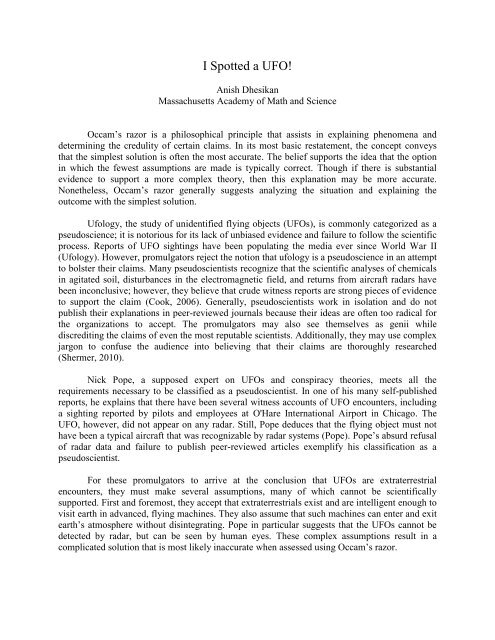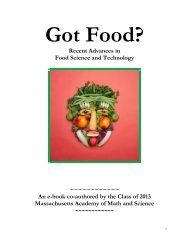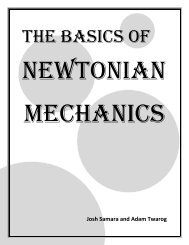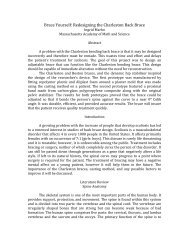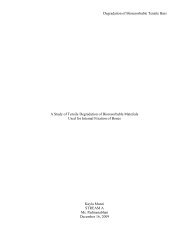I Spotted a UFO! - the Scientia Review
I Spotted a UFO! - the Scientia Review
I Spotted a UFO! - the Scientia Review
Create successful ePaper yourself
Turn your PDF publications into a flip-book with our unique Google optimized e-Paper software.
I <strong>Spotted</strong> a <strong>UFO</strong>!<br />
Anish Dhesikan<br />
Massachusetts Academy of Math and Science<br />
Occam’s razor is a philosophical principle that assists in explaining phenomena and<br />
determining <strong>the</strong> credulity of certain claims. In its most basic restatement, <strong>the</strong> concept conveys<br />
that <strong>the</strong> simplest solution is often <strong>the</strong> most accurate. The belief supports <strong>the</strong> idea that <strong>the</strong> option<br />
in which <strong>the</strong> fewest assumptions are made is typically correct. Though if <strong>the</strong>re is substantial<br />
evidence to support a more complex <strong>the</strong>ory, <strong>the</strong>n this explanation may be more accurate.<br />
None<strong>the</strong>less, Occam’s razor generally suggests analyzing <strong>the</strong> situation and explaining <strong>the</strong><br />
outcome with <strong>the</strong> simplest solution.<br />
Ufology, <strong>the</strong> study of unidentified flying objects (<strong>UFO</strong>s), is commonly categorized as a<br />
pseudoscience; it is notorious for its lack of unbiased evidence and failure to follow <strong>the</strong> scientific<br />
process. Reports of <strong>UFO</strong> sightings have been populating <strong>the</strong> media ever since World War II<br />
(Ufology). However, promulgators reject <strong>the</strong> notion that ufology is a pseudoscience in an attempt<br />
to bolster <strong>the</strong>ir claims. Many pseudoscientists recognize that <strong>the</strong> scientific analyses of chemicals<br />
in agitated soil, disturbances in <strong>the</strong> electromagnetic field, and returns from aircraft radars have<br />
been inconclusive; however, <strong>the</strong>y believe that crude witness reports are strong pieces of evidence<br />
to support <strong>the</strong> claim (Cook, 2006). Generally, pseudoscientists work in isolation and do not<br />
publish <strong>the</strong>ir explanations in peer-reviewed journals because <strong>the</strong>ir ideas are often too radical for<br />
<strong>the</strong> organizations to accept. The promulgators may also see <strong>the</strong>mselves as genii while<br />
discrediting <strong>the</strong> claims of even <strong>the</strong> most reputable scientists. Additionally, <strong>the</strong>y may use complex<br />
jargon to confuse <strong>the</strong> audience into believing that <strong>the</strong>ir claims are thoroughly researched<br />
(Shermer, 2010).<br />
Nick Pope, a supposed expert on <strong>UFO</strong>s and conspiracy <strong>the</strong>ories, meets all <strong>the</strong><br />
requirements necessary to be classified as a pseudoscientist. In one of his many self-published<br />
reports, he explains that <strong>the</strong>re have been several witness accounts of <strong>UFO</strong> encounters, including<br />
a sighting reported by pilots and employees at O'Hare International Airport in Chicago. The<br />
<strong>UFO</strong>, however, did not appear on any radar. Still, Pope deduces that <strong>the</strong> flying object must not<br />
have been a typical aircraft that was recognizable by radar systems (Pope). Pope’s absurd refusal<br />
of radar data and failure to publish peer-reviewed articles exemplify his classification as a<br />
pseudoscientist.<br />
For <strong>the</strong>se promulgators to arrive at <strong>the</strong> conclusion that <strong>UFO</strong>s are extraterrestrial<br />
encounters, <strong>the</strong>y must make several assumptions, many of which cannot be scientifically<br />
supported. First and foremost, <strong>the</strong>y accept that extraterrestrials exist and are intelligent enough to<br />
visit earth in advanced, flying machines. They also assume that such machines can enter and exit<br />
earth’s atmosphere without disintegrating. Pope in particular suggests that <strong>the</strong> <strong>UFO</strong>s cannot be<br />
detected by radar, but can be seen by human eyes. These complex assumptions result in a<br />
complicated solution that is most likely inaccurate when assessed using Occam’s razor.
Several simpler explanations can be given for <strong>the</strong> observed phenomenon. One very<br />
obvious <strong>the</strong>ory is that <strong>the</strong> entire idea of <strong>UFO</strong>s is a hoax, and that people all over <strong>the</strong> world<br />
dramatize <strong>the</strong> sight of flying objects in order to achieve fame. This explanation involves much<br />
fewer assumptions than does <strong>the</strong> promulgators’ ideas; hence, it is a simpler solution that is much<br />
more likely to be accurate. Ano<strong>the</strong>r <strong>the</strong>ory to rationalize <strong>the</strong> claim is space rock colliding with<br />
Earth’s atmosphere to create a flash of light visible to humans but not detectable by radars. With<br />
this idea, <strong>the</strong> only assumptions are that a space rock collides with <strong>the</strong> atmosphere to produce<br />
light, and this light is mistaken for an extraterrestrial flying machine. Although <strong>the</strong>se<br />
assumptions are also quite dubious, <strong>the</strong>y are simpler than those of <strong>the</strong> pseudoscientific claim, and<br />
are <strong>the</strong>refore more likely to be accurate.<br />
In <strong>the</strong> light of Occam’s razor, ufology is, indeed, a pseudoscience in that it purports a<br />
claim that is far too complex, and it is not supported by substantial scientific evidence.<br />
Promulgators of this assertion are often hermetic, and <strong>the</strong>y satisfy <strong>the</strong> criteria to be categorized as<br />
pseudoscientists. O<strong>the</strong>r, simpler explanations for <strong>the</strong> reporting of alleged <strong>UFO</strong>s contain fewer<br />
and simpler assumptions than those made by supporters of <strong>the</strong> claim. Thus, <strong>the</strong> study of ufology<br />
supports a <strong>the</strong>ory that is not accurate when examined using Occam’s razor and does not fare as a<br />
legitimate science.<br />
Literature Cited<br />
Cook, Ryan J. (2006). Anthropology & <strong>UFO</strong>s. Retrieved December 10, 2012 from<br />
http://www.anthroufo.info/au.html<br />
Pope, Nick (n.d.). Unidentified Flying Threats. Retrieved December 10, 2012 from<br />
http://www.nickpope.net/<br />
Shermer, M. (2010). Hermits and Cranks: Lessons from Martin Gardner on Recognizing<br />
Pseudoscientists. Scientific American. Retrieved December 6, 2012, from<br />
http://www.scientificamerican.com<br />
Ufology. (n.d.). In Wikipedia. Retrieved December 10, 2012, from Wikipedia:<br />
http://en.wikipedia.org/wiki/Ufology


